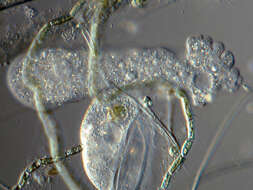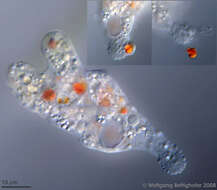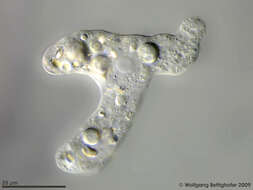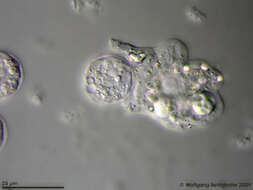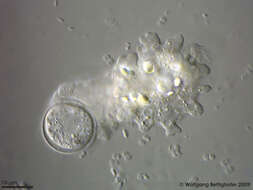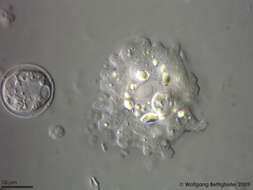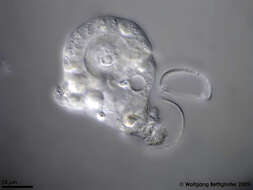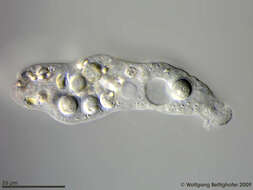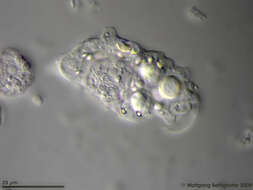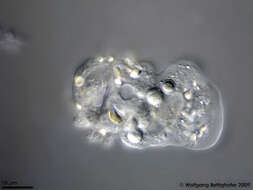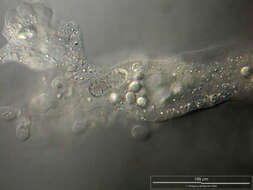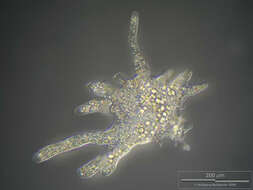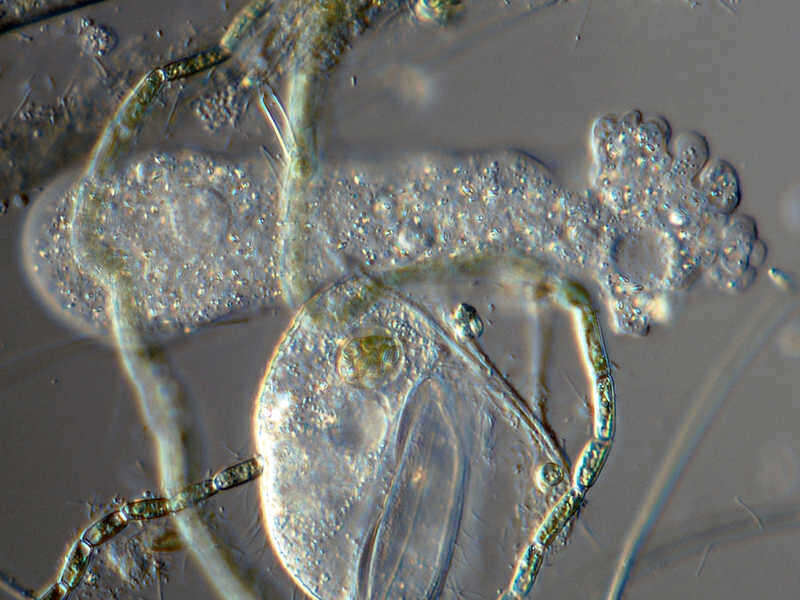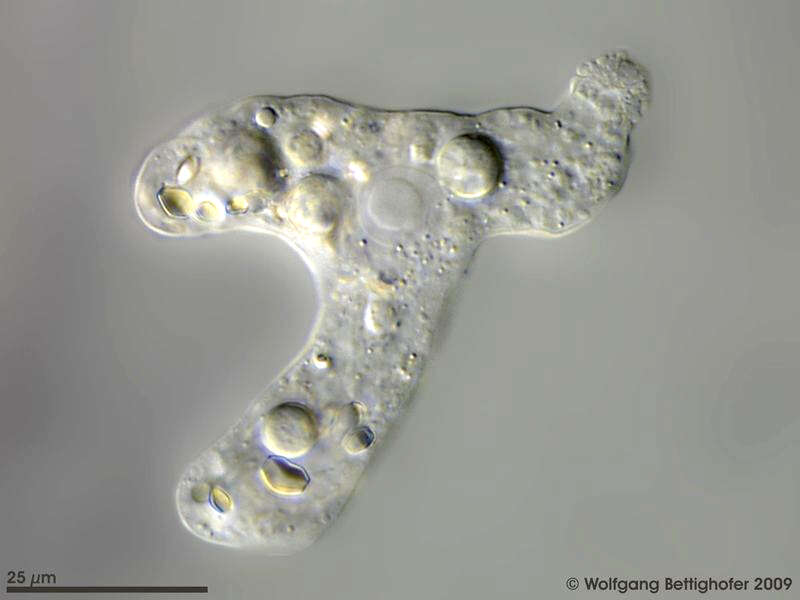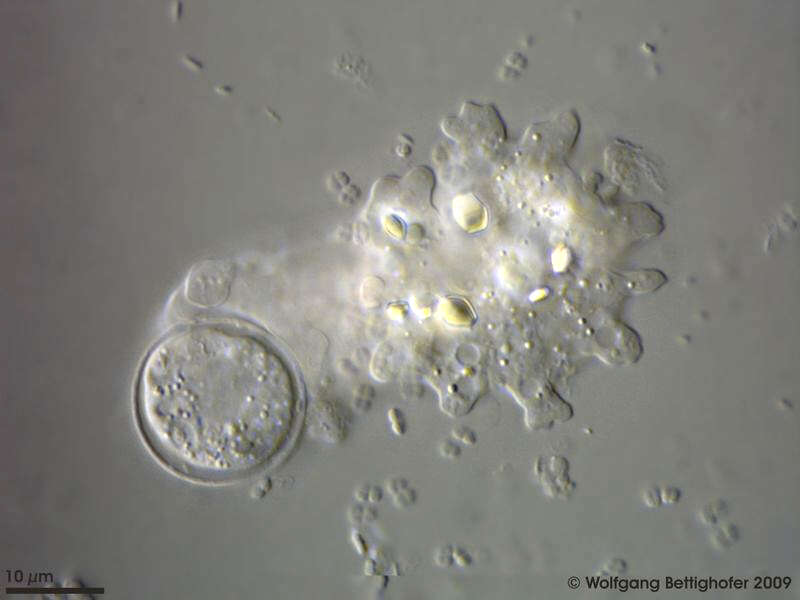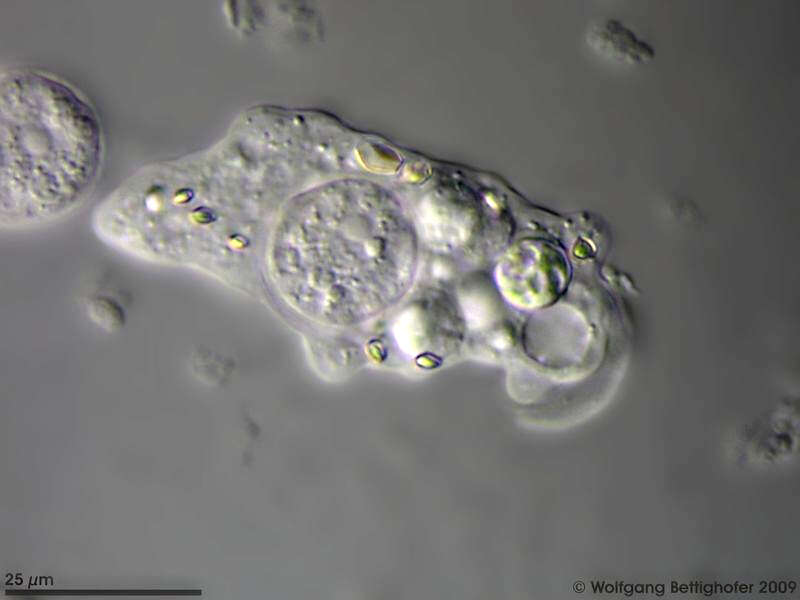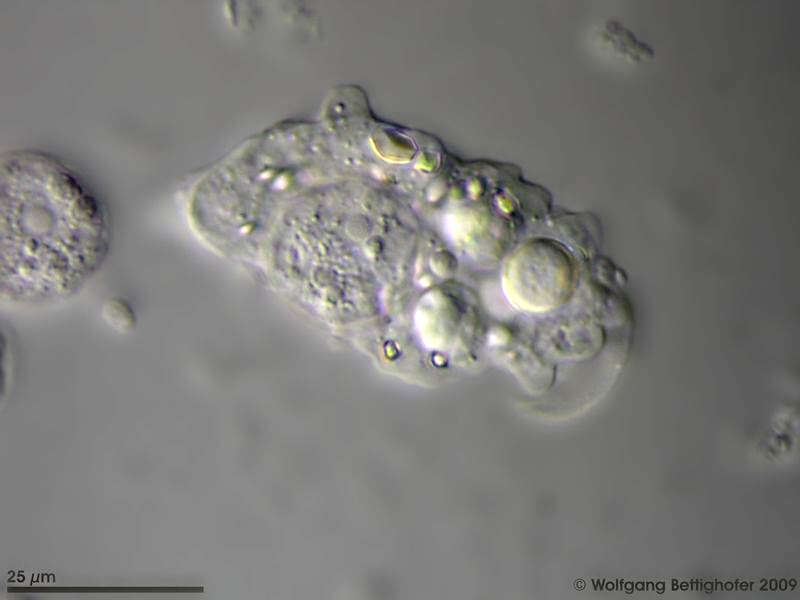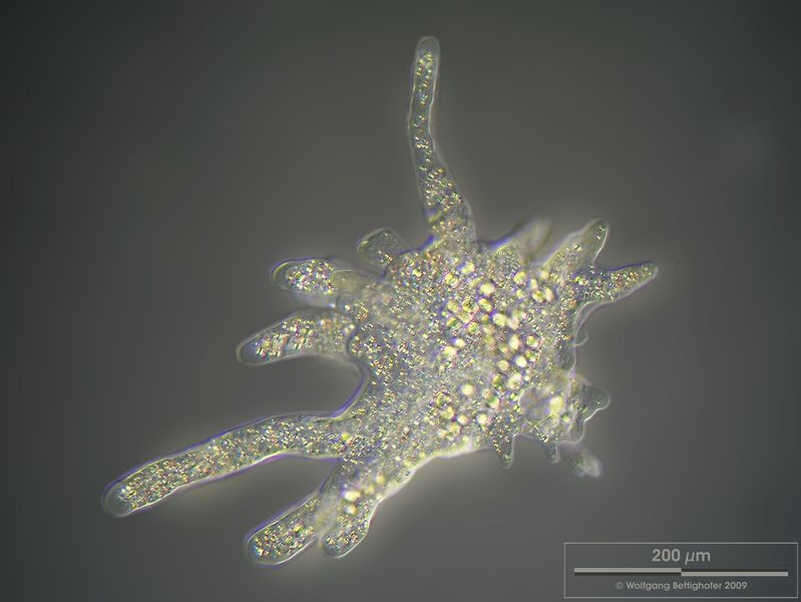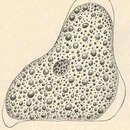-
Saccamoeba spec. Scale bar indicates 50 µm. Sample from the pond Hegne Moor situated in the vicinity of Lake Constance. The image was built up using several photomicrographic frames with manual stacking technique. Images were taken using Zeiss Universal with Olympus C7070 CCD camera.Image under Creative Commons License V 3.0 (CC BY-NC-SA). Place name: Bog Hegne Moor near Lake Constance (Germany) Latitude: 47.718106 Longitude: 9.093974 Multiebenen-Abbildung, manuell gestapelt. Der Messbalken markiert eine Länge von 50 µm. Probe aus dem Simmelried nahe Konstanz. Mikrotechnik: Zeiss Universal, Kamera: Olympus C7070. Creative Commons License V 3.0 (CC BY-NC-SA). For permission to use of (high-resolution) images please contact postmaster@protisten.de.
-
Saccamoeba spec. Scale bar indicates 50 µm. Sample from the pond Hegne Moor situated in the vicinity of Lake Constance. The image was built up using several photomicrographic frames with manual stacking technique. Images were taken using Zeiss Universal with Olympus C7070 CCD camera.Image under Creative Commons License V 3.0 (CC BY-NC-SA). Place name: Bog Hegne Moor near Lake Constance (Germany) Latitude: 47.718106 Longitude: 9.093974 Multiebenen-Abbildung, manuell gestapelt. Der Messbalken markiert eine Länge von 50 µm. Probe aus dem Simmelried nahe Konstanz. Mikrotechnik: Zeiss Universal, Kamera: Olympus C7070. Creative Commons License V 3.0 (CC BY-NC-SA). For permission to use of (high-resolution) images please contact postmaster@protisten.de.
-
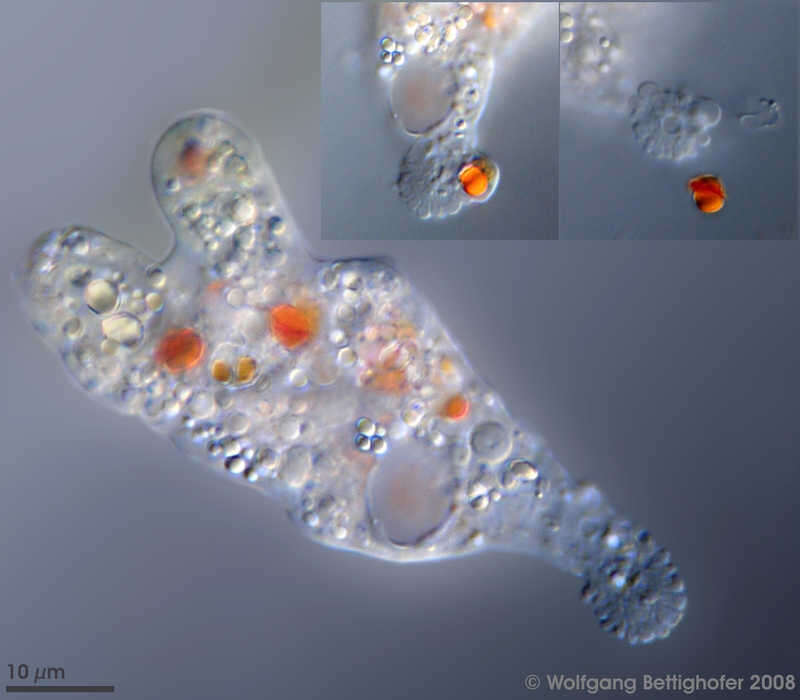
Saccamoeba limax Saccamoeba limax with its villous uroid. Two pseudopods protrude only during change of direction. During ordinary movement on substrate the appearance is monopodial. The inserts show states of defecation. Sample from sphagnum pond Dosenmoor near Neumuenster (Schleswig-Holstein, Germany). This image was taken using Zeiss Universal with Olympus C7070 CCD camera.Image under Creative Commons License V 3.0 (CC BY-NC-SA). Place name: Bog Dosenmoor near Neumuenster (Schleswig-Holstein, Germany) Latitude: 54.136219 Longitude: 10.026433 Saccamoeba limax mit ihrem zottigen Uroid. Nur während der Richtungsänderung sind zwei Pseudopodien zu sehen. Während der normalen Bewegung auf Substrat erscheint die Amöbe monopodial. Die Detailbilder zeigen Stadien der Defäkation. Probe aus dem Dosenmoor in der Nähe von Neumünster. Mikrotechnik: Zeiss Universal, Kamera: Olympus C7070. Creative Commons License V 3.0 (CC BY-NC-SA). For permission to use of (high-resolution) images please contact postmaster@protisten.de.
-
Saccamoeba limax Saccamoeba limax changes its direction of locomotion. During this period the classical, monopodial shape is lost. Sample from a freshwater pond on the island of Hiddensee (Baltic Sea, Germany). This image was taken using Zeiss Universal with Olympus C7070 CCD camera.Image under Creative Commons License V 3.0 (CC BY-NC-SA). Place name: Pond Suploch, Hiddensee (Germany) Latitude: 54.538638 Longitude: 13.097802 Saccamoeba limax ändert seine Fortbewegungsrichtung. Während dieser Phase geht die klassische, monopodiale Form verloren. Probe aus einem kleinen Süßwasserteich auf der Insel Hiddensee, welcher eine faszinierende Vielfalt von nackten und beschalten Amöben beherbergt. Mikrotechnik: Zeiss Universal, Kamera: Olympus C7070. Creative Commons License V 3.0 (CC BY-NC-SA). For permission to use of (high-resolution) images please contact postmaster@protisten.de.
-
Saccamoeba limax Phagocytosis of a Pyxidicula, phase II. Sample from a freshwater pond on the island of Hiddensee (Baltic Sea, Germany). This image was taken using Zeiss Universal with Olympus C7070 CCD camera.Image under Creative Commons License V 3.0 (CC BY-NC-SA). Place name: Pond Suploch, Hiddensee (Germany) Latitude: 54.538638 Longitude: 13.097802 Phagozytose einer Pyxidicula, Phase II. Probe aus einem kleinen Süßwasserteich auf der Insel Hiddensee, welcher eine faszinierende Vielfalt von nackten und beschalten Amöben beherbergt. Mikrotechnik: Zeiss Universal, Kamera: Olympus C7070. Creative Commons License V 3.0 (CC BY-NC-SA). For permission to use of (high-resolution) images please contact postmaster@protisten.de.
-
Saccamoeba limax Saccamoeba limax starting the uptake of a Pyxidicula cell. Sample from a freshwater pond on the island of Hiddensee (Baltic Sea, Germany). This image was taken using Zeiss Universal with Olympus C7070 CCD camera.Image under Creative Commons License V 3.0 (CC BY-NC-SA). Place name: Pond Suploch, Hiddensee (Germany) Latitude: 54.538638 Longitude: 13.097802 Saccamoeba limax beginnt mit der Aufnahme einer Pyxidicula-Zelle. Probe aus einem kleinen Süßwasserteich auf der Insel Hiddensee, welcher eine faszinierende Vielfalt von nackten und beschalten Amöben beherbergt. Mikrotechnik: Zeiss Universal, Kamera: Olympus C7070. Creative Commons License V 3.0 (CC BY-NC-SA). For permission to use of (high-resolution) images please contact postmaster@protisten.de.
-
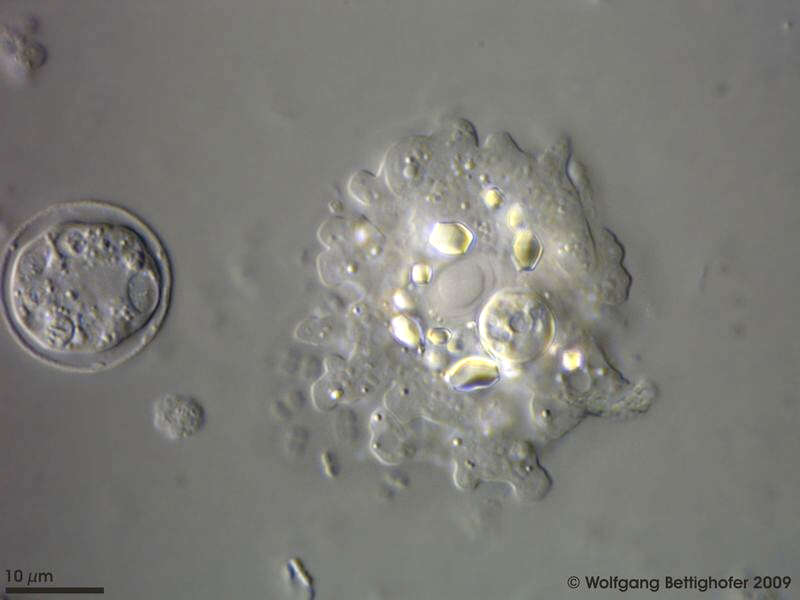
Saccamoeba limax Floating form of Saccamoeba limax with a characteristic villous collar and the cuboidal crystals. The vesicular nucleus with its huge central nucleolus lies in the middle of the cell. Left of Saccamoeba we can see the prey: Pyxidicula, a testate amoeba. Sample from a freshwater pond on the island of Hiddensee (Baltic Sea, Germany). This image was taken using Zeiss Universal with Olympus C7070 CCD camera.Image under Creative Commons License V 3.0 (CC BY-NC-SA). Place name: Pond Suploch, Hiddensee (Germany) Latitude: 54.538638 Longitude: 13.097802 Schwimmende Form von Saccamoeba limax mit characteristischem zottigen Kragen und quaderförmigen Kristallen. Der bläschenförmige Kern mit seinem riesigen zentralen Nukleolus liegt in der Mitte der Zelle. Links von Saccamoeba können wir ihre Beute sehen: Pyxidicula, eine Schalenamöbe. Probe aus einem kleinen Süßwasserteich auf der Insel Hiddensee, welcher eine faszinierende Vielfalt von nackten und beschalten Amöben beherbergt. Mikrotechnik: Zeiss Universal, Kamera: Olympus C7070. Creative Commons License V 3.0 (CC BY-NC-SA). For permission to use of (high-resolution) images please contact postmaster@protisten.de.
-
Saccamoeba limax Phagocytosis of a Pyxidicula, phase III. Sample from a freshwater pond on the island of Hiddensee (Baltic Sea, Germany). This image was taken using Zeiss Universal with Olympus C7070 CCD camera.Image under Creative Commons License V 3.0 (CC BY-NC-SA). Place name: Pond Suploch, Hiddensee (Germany) Latitude: 54.538638 Longitude: 13.097802 Phagozytose einer Pyxidicula, Phase III. Probe aus einem kleinen Süßwasserteich auf der Insel Hiddensee, welcher eine faszinierende Vielfalt von nackten und beschalten Amöben beherbergt. Mikrotechnik: Zeiss Universal, Kamera: Olympus C7070. Creative Commons License V 3.0 (CC BY-NC-SA). For permission to use of (high-resolution) images please contact postmaster@protisten.de.
-

Saccamoeba limax Saccamoeba limax in classical shape as it can be found in literature. There are several cuboidal crystals (typical for this species), food vacuoles and the vesicular nucleus with its huge central nucleolus. On the left the likewise typical finely papillate bulbous uroid which recalls the family Amoebidae. Sample from a tropical freshwater aquarium. This image was taken using Zeiss Axioplan with Canon EOS 600D.Image under Creative Commons License V 3.0 (CC BY-NC-SA). Place name: Tropical freshwater aquarium Latitude: 54.3018013 Longitude: 10.07120132 Saccamoeba limax in klassischer Form. Man erkennt eine Reihe quaderförmige Kristalle (typisch für diese Spezies), mehrere Nahrungsvakuolen und den bläschenförmigen Kern mit seinem riesigen zentralen Nucleolus. Am linken Zellende ist das ebenfalls typische fein papillöse bauchige Uroid zu sehen. Probe aus einem Süßwasseraquarium für tropische Fische. Mikrotechnik: Zeiss Axioplan, Kamera: Canon EOS 600D. Creative Commons License V 3.0 (CC BY-NC-SA). For permission to use of (high-resolution) images please contact postmaster@protisten.de.
-

Saccamoeba limax Phagocytosis of Pyxidicula has completed. On the right the typical finely papillate bulbous uroid which recalls the family Amoebidae. Two empty test of Pyxidicula had been discharged and stayed connected through fine plasma ribbons to the uroid. Scale bar indicates 10 µm. Sample from a freshwater pond on the island of Hiddensee (Baltic Sea, Germany). This image was taken using Zeiss Universal with Olympus C7070 CCD camera.Image under Creative Commons License V 3.0 (CC BY-NC-SA). Place name: Pond Suploch, Hiddensee (Germany) Latitude: 54.538638 Longitude: 13.097802 Die Phagozytose der Pyxidicula-Zelle ist abgeschlossen. Auf der rechten Seite ist das typische, fein papillös bauchige Uroid zu sehen, welches an die Uroidformen der Familie Amoebidae erinnert. Zwei leere Pyxidicula-Schalen sind ausgeschieden worden, blieben jedoch noch durch feine Plasma-Bänder mit dem Uroid verbunden. Der Messbalken markiert eine Länge von 10 µm. Probe aus einem kleinen Süßwasserteich auf der Insel Hiddensee, welcher eine faszinierende Vielfalt von nackten und beschalten Amöben beherbergt. Mikrotechnik: Zeiss Universal, Kamera: Olympus C7070. Creative Commons License V 3.0 (CC BY-NC-SA). For permission to use of (high-resolution) images please contact postmaster@protisten.de.
-
Saccamoeba limax Phagocytosis of a Pyxidicula, phase V. Sample from a freshwater pond on the island of Hiddensee (Baltic Sea, Germany). This image was taken using Zeiss Universal with Olympus C7070 CCD camera.Image under Creative Commons License V 3.0 (CC BY-NC-SA). Place name: Pond Suploch, Hiddensee (Germany) Latitude: 54.538638 Longitude: 13.097802 Phagozytose einer Pyxidicula, Phase V. Probe aus einem kleinen Süßwasserteich auf der Insel Hiddensee, welcher eine faszinierende Vielfalt von nackten und beschalten Amöben beherbergt. Mikrotechnik: Zeiss Universal, Kamera: Olympus C7070. Creative Commons License V 3.0 (CC BY-NC-SA). For permission to use of (high-resolution) images please contact postmaster@protisten.de.
-
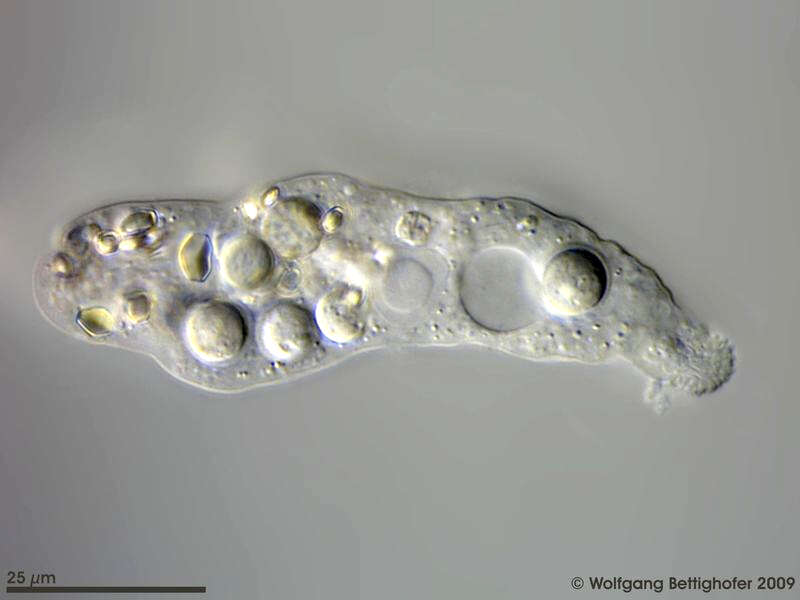
Saccamoeba limax Saccamoeba limax in classical shape as it can be found in literature. From the left to the right we see the cuboidal crystals (typical for this species), several food vacuoles, the vesicular nucleus with its huge central nucleolus, the contractile vacuole and another food vacuole. On the right the likewise typical finely papillate bulbous uroid which recalls the family Amoebidae. Sample from a freshwater pond on the island of Hiddensee (Baltic Sea, Germany). This image was taken using Zeiss Universal with Olympus C7070 CCD camera.Image under Creative Commons License V 3.0 (CC BY-NC-SA). Place name: Pond Suploch, Hiddensee (Germany) Latitude: 54.538638 Longitude: 13.097802 Saccamoeba limax in klassischer Form, wie es in der Literatur gefunden werden kann. Von links nach rechts sehen wir die quaderförmigen Kristalle (typisch für diese Spezies), mehrere Nahrungsvakuolen, den bläschenförmigen Kern mit seinem riesigen zentralen Nucleolus, die kontraktile Vakuole und eine weitere Nahrungsvakuole. Am rechten Zellende ist das ebenfalls typische fein papillöse bauchige Uroid zu sehen, welches an jene der Familie Amoebidae erinnert. Probe aus einem kleinen Süßwasserteich auf der Insel Hiddensee, welcher eine faszinierende Vielfalt von nackten und beschalten Amöben beherbergt. Mikrotechnik: Zeiss Universal, Kamera: Olympus C7070. Creative Commons License V 3.0 (CC BY-NC-SA). For permission to use of (high-resolution) images please contact postmaster@protisten.de.
-
Saccamoeba limax Phagocytosis of a Pyxidicula, phase IV. Sample from a freshwater pond on the island of Hiddensee (Baltic Sea, Germany). This image was taken using Zeiss Universal with Olympus C7070 CCD camera.Image under Creative Commons License V 3.0 (CC BY-NC-SA). Place name: Pond Suploch, Hiddensee (Germany) Latitude: 54.538638 Longitude: 13.097802 Phagozytose einer Pyxidicula, Phase IV. Probe aus einem kleinen Süßwasserteich auf der Insel Hiddensee, welcher eine faszinierende Vielfalt von nackten und beschalten Amöben beherbergt. Mikrotechnik: Zeiss Universal, Kamera: Olympus C7070. Creative Commons License V 3.0 (CC BY-NC-SA). For permission to use of (high-resolution) images please contact postmaster@protisten.de.
-

Saccamoeba limax Phagocytosis of Pyxidicula has completed. This image shows a specimen which has engulfed at least two Pyxidicula test, one on the left termination and another to the right of the big food vacuoles . Scale bar indicates 10 µm. Sample from a freshwater pond on the island of Hiddensee (Baltic Sea, Germany). This image was taken using Zeiss Universal with Olympus C7070 CCD camera.Image under Creative Commons License V 3.0 (CC BY-NC-SA). Place name: Pond Suploch, Hiddensee (Germany) Latitude: 54.538638 Longitude: 13.097802 Die Phagozytose der Pyxidicula-Zelle ist abgeschlossen. Dieses Bild zeigt ein Exemplar, die mindestens zwei Pyxidicula-Zellen verschlungen hat, eine am linken Zellende und eine andere auf der rechten Seite der großen Nahrungsvakuolen. Der Messbalken markiert eine Länge von 10 µm. Probe aus einem kleinen Süßwasserteich auf der Insel Hiddensee, welcher eine faszinierende Vielfalt von nackten und beschalten Amöben beherbergt. Mikrotechnik: Zeiss Universal, Kamera: Olympus C7070. Creative Commons License V 3.0 (CC BY-NC-SA). For permission to use of (high-resolution) images please contact postmaster@protisten.de.
-

Amoeba proteus Nucleus (center) and trailing uroid (upper left) of Amoeba proteus. To the right of the nucleus there are several food vacuoles. In addition many tiny crystals are visible. Scale bar indicates 100 µm. The specimen was gathered in a tiny freshwater pond at the island of Hiddensee (Baltic Sea, Germany) which shows a fascinating biodiversity of naked and testate amoebae. Images were taken using Zeiss Standard with Olympus C7070 CCD camera.Image under Creative Commons License V 3.0 (CC BY-NC-SA). Place name: Pond Suploch, Hiddensee (Germany) Latitude: 54.538638 Longitude: 13.097802 Nucleus (in der Mitte) und Uroid am Hinterende (oben links) von Amoeba proteus. Auf der rechten Seite des Kerns liegen mehrere Nahrungsvakuolen. Weiter sind vielen kleine Kristalle sichtbar.Der Messbalken zeigt 100 µm an. Probe aus einem kleinen Süßwasserteich auf der Insel Hiddensee, der eine faszinierende Vielfalt von nackten und beschalten Amöben beherbergt. Mikrotechnik: Zeiss Universal, Kamera: Olympus C7070. Creative Commons License V 3.0 (CC BY-NC-SA). For permission to use of (high-resolution) images please contact postmaster@protisten.de.
-
Amoeba proteus Amoeba proteus with numerous crystals showing typical polypodial movement. Scale bar indicates 200 µm. The specimen was gathered in a tiny freshwater pond at the island of Hiddensee (Baltic Sea, Germany) which shows a fascinating biodiversity of naked and testate amoebae. Images were taken using Zeiss Standard with Olympus C7070 CCD camera.Image under Creative Commons License V 3.0 (CC BY-NC-SA). Place name: Pond Suploch, Hiddensee (Germany) Latitude: 54.538638 Longitude: 13.097802 Amoeba proteus mit zahlreichen Kristallen und typischer polypodialer Bewegung. Der Messbalken zeigt 200 µm. Probe aus einem kleinen Süßwasserteich auf der Insel Hiddensee, der eine faszinierende Vielfalt von nackten und beschalten Amöben beherbergt. Mikrotechnik: Zeiss Universal, Kamera: Olympus C7070. Creative Commons License V 3.0 (CC BY-NC-SA). For permission to use of (high-resolution) images please contact postmaster@protisten.de.
-

Amoeba proteus Higher magnification of cell zone with nucleus. Left the contractile vacuole, then food vacuoles to the right of the CV. The nucleus shows his scattered nucluolus beneath the nuclear membrane (parietal arranged). The specimen was gathered in a tiny freshwater pond at the island of Hiddensee (Baltic Sea, Germany) which shows a fascinating biodiversity of naked and testate amoebae. Images were taken using Zeiss Standard with Olympus C7070 CCD camera.Image under Creative Commons License V 3.0 (CC BY-NC-SA). Place name: Pond Suploch, Hiddensee (Germany) Latitude: 54.538638 Longitude: 13.097802 Höhere Vergrößerung der Zone, die den Zellkern enthält. Links die kontraktile Vakuole (kV), Nahrungsvakuolen auf der rechten Seite der kV. Der Kern zeigt seine verstreuten Nucleoli, die dicht unter der Kernmembran liegen (= parietal angeordnet). Probe aus einem kleinen Süßwasserteich auf der Insel Hiddensee, der eine faszinierende Vielfalt von nackten und beschalten Amöben beherbergt. Mikrotechnik: Zeiss Universal, Kamera: Olympus C7070. Creative Commons License V 3.0 (CC BY-NC-SA). For permission to use of (high-resolution) images please contact postmaster@protisten.de.

